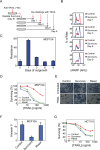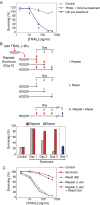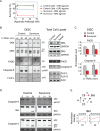Cells surviving fractional killing by TRAIL exhibit transient but sustainable resistance and inflammatory phenotypes
- PMID: 23699397
- PMCID: PMC3708725
- DOI: 10.1091/mbc.E12-10-0737
Cells surviving fractional killing by TRAIL exhibit transient but sustainable resistance and inflammatory phenotypes
Abstract
When clonal populations of human cells are exposed to apoptosis-inducing agents, some cells die and others survive. This fractional killing arises not from mutation but from preexisting, stochastic differences in the levels and activities of proteins regulating apoptosis. Here we examine the properties of cells that survive treatment with agonists of two distinct death receptors, tumor necrosis factor-related apoptosis-inducing ligand (TRAIL) and anti-FasR antibodies. We find that "survivor" cells are highly resistant to a second ligand dose applied 1 d later. Resistance is reversible, resetting after several days of culture in the absence of death ligand. "Reset" cells appear identical to drug-naive cells with respect to death ligand sensitivity and gene expression profiles. TRAIL survivors are cross-resistant to activators of FasR and vice versa and exhibit an NF-κB-dependent inflammatory phenotype. Remarkably, reversible resistance is induced in the absence of cell death when caspase inhibitors are present and can be sustained for 1 wk or more, also without cell death, by periodic ligand exposure. Thus stochastic differences in cell state can have sustained consequences for sen-sitivity to prodeath ligands and acquisition of proinflammatory phenotypes. The important role played by periodicity in TRAIL exposure for induction of opposing apoptosis and survival mechanisms has implications for the design of optimal therapeutic agents and protocols.
Figures








Similar articles
-
Death receptor 5 is activated by fucosylation in colon cancer cells.FEBS J. 2019 Feb;286(3):555-571. doi: 10.1111/febs.14742. Epub 2019 Jan 14. FEBS J. 2019. PMID: 30589515 Free PMC article.
-
Human melanoma cells selected for resistance to apoptosis by prolonged exposure to tumor necrosis factor-related apoptosis-inducing ligand are more vulnerable to necrotic cell death induced by cisplatin.Clin Cancer Res. 2006 Feb 15;12(4):1355-64. doi: 10.1158/1078-0432.CCR-05-2084. Clin Cancer Res. 2006. PMID: 16489094
-
Human embryonic and induced pluripotent stem cells express TRAIL receptors and can be sensitized to TRAIL-induced apoptosis.Stem Cells Dev. 2013 Nov 15;22(22):2964-74. doi: 10.1089/scd.2013.0057. Epub 2013 Aug 2. Stem Cells Dev. 2013. PMID: 23806100 Free PMC article.
-
Targeting TNF-related apoptosis-inducing ligand (TRAIL) receptor by natural products as a potential therapeutic approach for cancer therapy.Exp Biol Med (Maywood). 2015 Jun;240(6):760-73. doi: 10.1177/1535370215579167. Epub 2015 Apr 7. Exp Biol Med (Maywood). 2015. PMID: 25854879 Free PMC article. Review.
-
Mechanisms of resistance to TRAIL-induced apoptosis in cancer.Cancer Gene Ther. 2005 Mar;12(3):228-37. doi: 10.1038/sj.cgt.7700792. Cancer Gene Ther. 2005. PMID: 15550937 Review.
Cited by
-
Targeting of BCL-2 Family Members during Anticancer Treatment: A Necessary Compromise between Individual Cell and Ecosystemic Responses?Biomolecules. 2020 Jul 25;10(8):1109. doi: 10.3390/biom10081109. Biomolecules. 2020. PMID: 32722518 Free PMC article. Review.
-
Emerging approaches to target mitochondrial apoptosis in cancer cells.F1000Res. 2019 Oct 24;8:F1000 Faculty Rev-1793. doi: 10.12688/f1000research.18872.1. eCollection 2019. F1000Res. 2019. PMID: 31681471 Free PMC article. Review.
-
TRAIL signaling promotes entosis in colorectal cancer.J Cell Biol. 2021 Nov 1;220(11):e202010030. doi: 10.1083/jcb.202010030. Epub 2021 Sep 21. J Cell Biol. 2021. PMID: 34546352 Free PMC article.
-
The role of the immune response and inflammatory pathways in TNF-related apoptosis-inducing ligand (TRAIL) resistance in triple-negative breast cancer cells.Am J Cancer Res. 2023 Oct 15;13(10):4678-4692. eCollection 2023. Am J Cancer Res. 2023. PMID: 37970367 Free PMC article.
-
NF-κB signalling and cell fate decisions in response to a short pulse of tumour necrosis factor.Sci Rep. 2016 Dec 22;6:39519. doi: 10.1038/srep39519. Sci Rep. 2016. PMID: 28004761 Free PMC article.
References
-
- Adams C, et al. Structural and functional analysis of the interaction between the agonistic monoclonal antibody Apomab and the proapoptotic receptor DR5. Cell Death Differ. 2008;15:751–761. - PubMed
-
- Ashkenazi A. Targeting the extrinsic apoptosis pathway in cancer. Cytokine Growth Factor Rev. 2008;19:325–331. - PubMed
-
- Ashkenazi A, Dixit VM. Apoptosis control by death and decoy receptors. Curr Opin Cell Biol. 1999;11:255–260. - PubMed
Publication types
MeSH terms
Substances
Grants and funding
LinkOut - more resources
Full Text Sources
Other Literature Sources
Molecular Biology Databases
Research Materials

